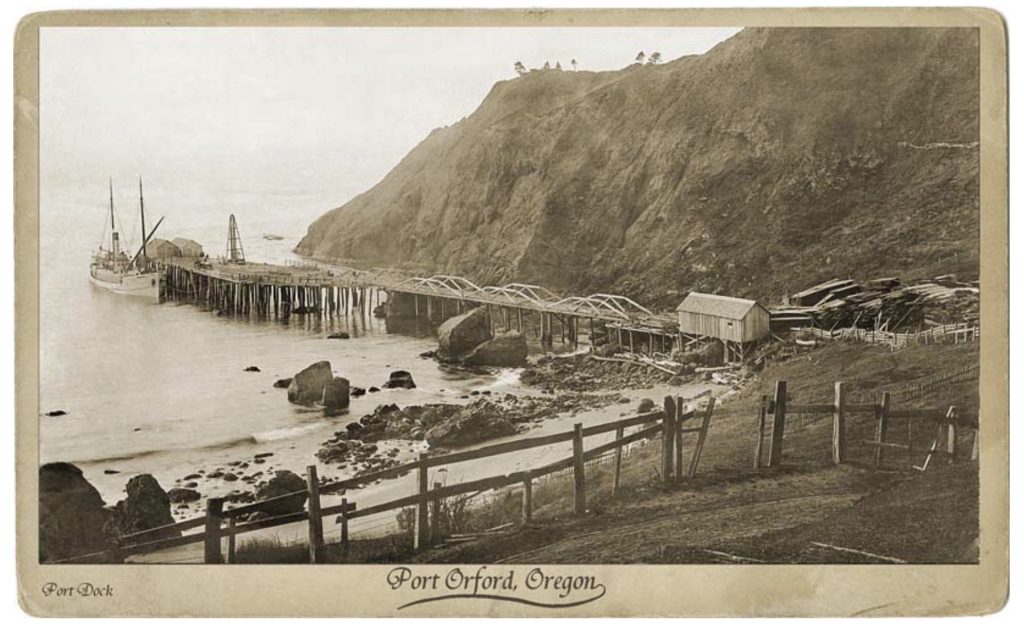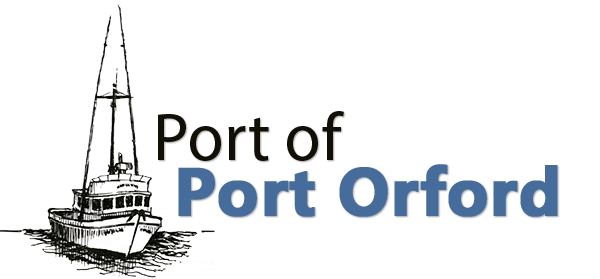Before the arrival of European settlers, the Port Orford area was inhabited by Tututni people.The Tututni languages were a part of the Pacific Coast Athabaskan language family.
The First European settlers, led by Captain William Tichenor, arrived in 1851. Tichenor, needing to return to the north for supplies, left a group of nine men behind. However, members of the local Qua-to mah tribe reacted with hostility to the newcomers, who were encroaching on their territory. Taking up a position on a nearby seastack, now known as Battle Rock, the settlers were attacked by a band of more than 100 Qua-to-mahs. Twenty-three natives were killed, and two of Tichenor’s men were wounded in the ensuing conflict. Soon afterward, a truce was called between the two groups, when the settlers told the natives that they would be leaving in 14 days. For the next two weeks, the settlers did not see any members of the local tribe. However, after the 14th day, an even larger band of natives than the first attacked. During the battle, the chief of the tribe was killed. Retreating with their dead chief, the tribe set up camp nearby. The settlers soon fled north under cover of darkness.
Port Orford was formally founded in 1856. It would serve as a receiving port for mercantile and fishing. Although Port Orford cedar (Chamaecyparis lawsoniana) was being shipped from the harbor as early as 1853 and throughout the late 19th century, the port district was not formally established until 1911, when the town became an official shipping hub for the locally harvested cedar. The port was sold in 1935, but brought back in 1957. Eventually, Port Orford saw a decline in fishing and the shipping of timber ceased.
The Port of Port Orford harbor that has been in use since the 1850s, and was primarily used for shipping lumber. The firs Port District was formed in 1911 and dock construction began in 1919. A breakwater was built in 1971 in an attempt to protect the dock from winter storms. Shoaling became a problem shortly after and dredging became necessary. Although no longer a deep harbor, Port Orford is still home to many commercial fisherman and is used as a harbor of refuge by many during severe storms.
In October 1941, then-mayor Gilbert Gable, frustrated with the poor condition of the state roads around Port Orford, which hampered economic development, suggested that a number of counties along the Oregon and California state border should secede and create the State of Jefferson. This movement came to an end with U.S. involvement in World War II. The port is an open-water dock (no natural protection) and boasts the only dry-dock port of the West Coast. The fishing boats are lifted in and out of the water by operated cranes, set on custom-made dollies and parked in rows on the dock. As a result, it is known as a “dolly dock”. The Port is located right on the Oregon coast, just 75 miles north of the California boarder.

THE PORT WITH NO BAR TO CROSS
A unique aspect of the Port of Port Orford is the fact that there is no ocean bar to cross. This results in more fishable days per year. Ocean access is gained by use of one of the Port’s hoists, which can lift boats weighing up to 25,000 pounds. Since the Port is situated on the open ocean, moorage in the water is only possible for short periods during calmer weather. Thus all commercial boats from Port Orford have trailers on which they are kept upon the dock. The Port has two hoists available.
SPORTS, FISHING, DIVING AND KAYAKING
The Port has improved parking facilities to include boat and trailer parking spaces and additional automobile parking.
Many ocean sport fishermen favor Port Orford as there is no dangerous bar to cross, and good fishing just a few minutes from the dock. The Orford and Blanco reefs offer excellent bottom fishing in an uncrowned area.
Port Orford is rapidly becoming the dive-site of choice for many Oregon divers. Long noted for its spectacular under-sea beauty, ease of access, diveable shipwrecks, and exceptional visibility, in addition to the close proximity to Nellies and Tichenor’s Coves. Dive classes have been conducted by places such as Eugene, Roseburg, and the Medford-Grants Pass area. The Port has restrooms & shower facilities to further accommodate divers. There are outside showers available to clean your gear and inside showers for the use of the public. Kayaking is becoming more and more popular at the Port with the large and beautiful headland protected by Oregon State Parks full of secret coves, a cultural site, kelp beds, you can paddle through Arch Rock, access to and views of Redfish Rocks Marine Reserve and Humbug Mountain to the south. You can fish from your kayak for Ling Cod, Kelp Greenling, Black Rockfish, and other species of rockfish. You will also see colonies of Cormorants, Black Oyster Catchers, and common Murre’s. It is not uncommon to see Gray Whales and Orcas. The Port is always trying to improve accessibility for all the different users of the Port facilities.
